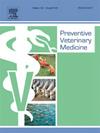Antimicrobial drugs used in the prevention and control of protozoal and bacterial calf diarrhea: A scoping review
IF 2.2
2区 农林科学
Q1 VETERINARY SCIENCES
引用次数: 0
Abstract
This scoping review examined the scientific literature on antimicrobial use (AMU) for preventing and controlling calf diarrhea. Secondary aims included describing health assessment methods and exploring the feasibility of meta-analyses to assess antimicrobial drug (AMs) efficacy. Following a registered protocol, four electronic databases were searched (initial search 2019; last update 2023). Eligibility criteria required controlled trials evaluating AMU for diarrhea prevention and control in calves ≤ 6 months, with efficacy assessed through health outcomes and/or fecal pathogen shedding. The search yielded 4486 references. After deduplication, two reviewers screened titles (n = 3259), abstracts (n = 341), and full texts (n = 106), resulting in the inclusion of 43 articles encompassing 62 trials. Pathogens associated with diarrhea included Eimeria spp. (41.9 %), Cryptosporidium spp. (40.3 %), Salmonella spp. (8.1 %), and Escherichia coli (3.2 %). High variability and frequent incomplete reporting of trial methodologies were observed. The most frequently assessed AMs were diclazuril, toltrazuril, and lasalocid for Eimeria, and halofuginone, chlortetracycline, and oxytetracycline for Cryptosporidium, Salmonella, and E. coli, respectively. Fecal consistency (93.5 %) and stool blood (48.4 %) were the most commonly evaluated fecal traits, while microscopy-based quantitative (50 %) and semi-quantitative (48.4 %) tests were frequently used for fecal pathogen shedding. Results suggest that meta-analyses could be performed to evaluate AM efficacy for diarrhea associated with Cryptosporidium and Eimeria. Future research should assess the efficacy of AMs approved by regulatory agencies, refine diagnostic methods for evaluating diarrhea etiology, validate health assessment techniques, and compare the efficacy of management practices in preventing and controlling calf diarrhea.
用于预防和控制原生动物和细菌性小牛腹泻的抗菌药物:范围综述
这一范围审查审查的科学文献抗菌药物的使用(AMU)预防和控制小牛腹泻。次要目的包括描述健康评估方法和探索meta分析评估抗菌药物(AMs)疗效的可行性。按照注册协议,检索了四个电子数据库(初始检索2019;最后更新2023)。入选标准要求在≤ 6个月的犊牛中进行对照试验,评估AMU预防和控制腹泻的效果,并通过健康结局和/或粪便病原体脱落来评估疗效。搜索产生了4486条参考文献。在重复数据删除后,两位审稿人筛选了标题(n = 3259)、摘要(n = 341)和全文(n = 106),结果纳入了43篇文章,包括62项试验。与腹泻相关的病原体包括艾美耳球虫(41.9 %)、隐孢子虫(40.3 %)、沙门氏菌(8.1 %)和大肠杆菌(3.2 %)。观察到试验方法的高可变性和频繁的不完整报告。最常评估的AMs分别是用于艾美耳虫的双祖利、托曲祖利和lasalocid,以及用于隐孢子虫、沙门氏菌和大肠杆菌的halofuginone、氯四环素和土霉素。粪便黏稠度(93.5 %)和粪血(48.4 %)是最常评估的粪便特征,而基于显微镜的定量(50 %)和半定量(48.4 %)试验常用于粪便病原体脱落。结果表明,可以进行荟萃分析来评估AM对隐孢子虫和艾美耳虫相关腹泻的疗效。未来的研究应评估监管机构批准的AMs的疗效,完善评估腹泻病因的诊断方法,验证健康评估技术,并比较管理实践在预防和控制小牛腹泻方面的效果。
本文章由计算机程序翻译,如有差异,请以英文原文为准。
求助全文
约1分钟内获得全文
求助全文
来源期刊

Preventive veterinary medicine
农林科学-兽医学
CiteScore
5.60
自引率
7.70%
发文量
184
审稿时长
3 months
期刊介绍:
Preventive Veterinary Medicine is one of the leading international resources for scientific reports on animal health programs and preventive veterinary medicine. The journal follows the guidelines for standardizing and strengthening the reporting of biomedical research which are available from the CONSORT, MOOSE, PRISMA, REFLECT, STARD, and STROBE statements. The journal focuses on:
Epidemiology of health events relevant to domestic and wild animals;
Economic impacts of epidemic and endemic animal and zoonotic diseases;
Latest methods and approaches in veterinary epidemiology;
Disease and infection control or eradication measures;
The "One Health" concept and the relationships between veterinary medicine, human health, animal-production systems, and the environment;
Development of new techniques in surveillance systems and diagnosis;
Evaluation and control of diseases in animal populations.
 求助内容:
求助内容: 应助结果提醒方式:
应助结果提醒方式:


